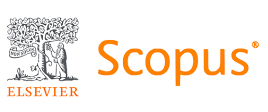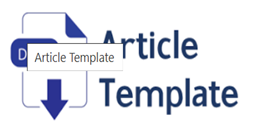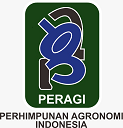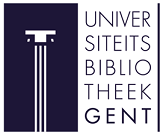Efficacy of Biofungicide with Active Ingredients Trichoderma sp. Against Late Blight Disease (Phytophthora infestans) in Potato Plants
Abstract
The cultivation of potatoes in Indonesia faces challenges, particularly a decline in production attributed to the devastating impact of late blight caused by the fungus P. infestans. Traditional control methods involve the frequent use of chemical pesticides, which pose environmental and health risks. To address this, the research aimed to assess the efficacy of biofungicide containing Trichoderma sp. as a biological agent in controlling late blight on potatoes. The study, conducted in Sumberbrantas Village, Bumiaji District, Batu City, East Java, and the plant disease laboratory at Brawijaya University from January to April 2023, employed both in vivo and in vitro experiments. A Randomized Block Design (RBD) was used for in vivo research, while a Completely Randomized Design (CRD) was employed for in vitro studies, each comprising five concentration treatments with five repetitions. Parameters such as disease intensity, efficacy level, potato production, and biofungicide inhibition were observed. Analysis of variance and the Tukey Honestly Significant Difference (HSD) test were applied to the data and processed using Microsoft Excel. The results indicated that biofungicide with Trichoderma sp. concentrations of 6 ml/l, 4.5 ml/l, 3 ml/l, and 1.5 ml/l effectively reduced the intensity of late blight on potatoes, with efficacy levels exceeding 50%. The highest potato production occurred with a concentration of 6 ml/l, yielding 15.44 tons/ha, followed by 14.67 tons/ha for the 4.5 ml/l concentration. The biofungicide with a concentration of 6 ml/l exhibited the lowest disease intensity at 14.28% and the highest efficacy at 83.08%. Inhibition tests demonstrated that concentrations of 6 ml/l and 4.5 ml were highly effective, inhibiting P. infestans growth by an average of 62.04% and 59.90%, respectively. These findings highlight the potential of biofungicide with Trichoderma sp. in managing late blight on potatoes, providing a sustainable and environmentally friendly alternative to chemical pesticides.
Keywords
Full Text:
PDFReferences
Adiyoga, W. (2009). Costs and Benefits of Transgenic Late Blight Resistant Potatoes in Indonesia. For FruIts & VegetABles, 86.
Alfia, A. D., & Haryadi, N. T. (2022). Pengujian Konsentrasi Biofungisida Cair Berbahan Aktif Trichoderma sp. Dalam Pengendalian Penyakit Antraknosa (Colletotrichum sp.) Pada Cabai Di Lapang. Berkala Ilmiah Pertanian, 5(2), 58–64. DOI: https://doi.org/10.19184/bip.v5i2.28858
Ali, M., & Samosir, I. Y. (2021). Uji Antagonisme Jamur Endofit Tanaman Aren (Arenga pinnata Merr.) terhadap Ganoderma boninense Pat. Penyebab Penyakit Busuk Pangkal Batang Kelapa Sawit. Agrikultura, 32(3), 304–311. DOI: https://doi.org/10.24198/agrikultura.v32i3.36611
Ambarwati, A. D. (2019). Kentang Tahan Penyakit Hawar Daun (Phytophthora infestans) yang Ramah Lingkungan. Balai Besar Penelitian dan Pengembangan Bioteknologi dan Sumber Daya Genetik Pertanian. https://repository.pertanian.go.id/server/api/core/bitstreams/d01c5054-cbb1-4af1-9311-ebb11846a593/content
Ambarwati, A. D., Kusmana, & Listanto, E. (2016). Klon-klon Kentang Transgenik Hasil Persilangan Terseleksi Tahan terhadap Penyakit Hawar Daun Phytophthora infestans Tanpa Penyemprotan Fungisida di Empat Lapangan Uji Terbatas. Jurnal Biologi Indonesia, 11(2), Article 2. DOI: https://doi.org/10.14203/jbi.v11i2.2191
Baihaqi, A., Nawawi, M., & Abadi, A. L. (2013). Teknik Aplikasi Trichoderma sp. terhadap Pertumbuhan dan Hasil Tanaman Kentang (Solanum tuberosum L.). J. Produksi Tanam, 1(3), 30–39.
Brugman, E., Purajanti, E. D., & Fuskhah, E. (2017). Pengendalian Penyakit Hawarbackslash(Lateblight) pada Kentang (Solanum tuberosum L.) melalui Penerapan Solarisasi Tanah dan Aplikasi Agen Hayati Trichoderma harzianum. [PhD Thesis, Fakultas Peternakan Dan Pertanian Undip]. DOI: https://doi.org/10.14710/joac.1.2.31-38
Cikita, D., Khotimah, S., & Linda, R. (2016). Uji Antagonis Trichoderma spp. terhadap Phytophthora palmivora Penyebab Penyakit Busuk Buah Kakao (Theobroma cacao L.). Jurnal Protobiont, 5(3). https://jurnal.untan.ac.id/index.php/jprb/article/view/17016
Direktorat Jendral Prasarana dan Sarana Pertanian. (2013). Metode Standar Pengujian Efikasi Fungisida. Ditjen PSP.
Elfina, Y., Ali, M., & Sabatiny, D. (2017). Uji Konsentrasi Biofungisida Tepung Trichoderma harzianum Rifai terhadap Jamur Phytophthora palmivora Butl. Penyebab Penyakit Busuk Buah Kakao Pasca Panen. Sagu, 16(1), 1–12. DOI: https://doi.org/10.24925/turjaf.v3i12.904-907.325
Gusnawaty, H. S., Taufik, M., & Herman, H. (2014). Efektifitas Trichoderma Indigenus Sulawesi Tenggara sebagai Biofungisida terhadap Colletotrichum sp. Secara In-Vitro. Jurnal Agroteknos, 4(1), 244375. DOI: https://doi.org/10.56189/ja.v4i1.204
Harman, G. E. (2006). Overview of Mechanisms and Uses of Trichoderma spp. Phytopathology, 96(2), 190–194. DOI: https://doi.org/10.1094/PHYTO-96-0190
Kaunang, R. A., Assa, B. H., & Montong, V. B. (2018). Uji Antagonisme Trichoderma spp. terhadap Phytophthora palmivora Penyebab Penyakit Gugur Buah Kelapa. COCOS, 10(1).
Kumar, V., Singh, R., Doharey, R. K., & Kumar, S. (2020). Evaluation of The Effect of Different Fungicides Against Phytophthora infestans (Mont) de Bary (In Vitro). Journal of Pharmacognosy and Phytochemistry, 9(3), 1935–1942.
Lontsi, S. L. D., Heu, A., Fovo, J. D., Tueguem, W. N. K., Biamen, M., Gbaporo, F. C. G., & Ambang, Z. (2020). Characterization of Phytophthora infestans Isolates from Two Potato Varieties in the Highlands Agro-Ecological Zone of Cameroon. International Journal of Pathogen Research, 5(1), 36–44. DOI: https://doi.org/10.9734/ijpr/2020/v5i130126
Molebila, D. Y., Rosmana, A., & Tresnaputra, U. S. (2020). Trichoderma Asal Akar Kopi dari Alor: Karakterisasi Morfologi dan Keefektifannya Menghambat Colletotrichum Penyebab Penyakit Antraknosa secara In Vitro. Jurnal Fitopatologi Indonesia, 16(2). DOI: 61–68. https://doi.org/10.14692/jfi.16.2.61-68
Pandawani, N. P., Widnyana, I. K., & Sumantra, I. K. (2020). Efektivitas Isolat Trichoderma spp. Dalam Pengendalian Penyakit Akar Gada (Plasmodiaphora brassicae Wor.) pada Sawi Hijau (Brassica rapa). Agro Bali: Agricultural Journal, 3(1), 38–51. DOI: https://doi.org/10.37637/ab.v3i1.422
Purwantisari, S., Femiah, R. S., & Rah, B. (2008). Pengendalian Hayati Penyakit Hawar Daun Tanaman Kentang dengan Agen Hayati Jamur-jamur Antagonis Isolat Lokal. Bioma.
Purwantisari, S., Priyatmojo, A., Sancayaningsih, R. P., & Kasiamdari, R. S. (2015). Aplikasi Jamur Antagonis Trichoderma viride terhadap Pengurangan Intensitas Serangan Penyakit Hawar Daun serta Hasil Tanaman Kentang. [Seminar Nasional Konservasi dan Sumber Daya Alam]. Universitas Sebelas Maret.
Purwantisari, S., Priyatmojo, A., Sancayaningsih, R. P., & Kasiamdari, R. S. (2016). Masa Inkubasi Gejala Penyakit Hawar Daun Tanaman Kentang yang Diinduksi Ketahanannya oleh Jamur Antagonis Trichoderma viride. Bioma: Berkala Ilmiah Biologi, 18(2), 41–47. DOI: https://doi.org/10.14710/bioma.18.2.41-47
Sa’diyah, H., Roviq, M., & Wardiyati, T. (2017). Pengaruh Pemberian Agen Hayati pada Pertumbuhan dan Hasil Lima Varietas Kentang (Solanum tuberosum L.) di Bumiaji, Batu. Jurnal Produksi Tanaman, 5(10), 1708–1715.
Sastrahidayat, I. R. (1992). Seri Umum: Ilmu Penyakit Tumbuhan. Usaha Nasional.
Wattimury, M., Taribuka, J., & Siregar, A. (2021). Penggunaan Trichoderma Endofitik untuk Mengendalikan Penyakit Busuk Buah Phytophthora infestans, Pertumbuhan dan Hasil Tanaman Tomat. Jurnal Agrologia, 10(1), 45–53. DOI: https://doi.org/10.30598/ajibt.v10i1.1298
Susetyo, H. P. (2023). Penyakit Busuk Daun Kentang. Direktorat Jenderal Hortikultura Kementrian Pertanian. https://hortikultura.pertanian.go.id/penyakit-busuk-daun-kentang/
Wightwick, A., Walters, R., Allinson, G., Reichman, S., & Menzies,
N. (2010). Environmental Risks of Fungicides Used in Horticultural Production Systems. Fungicides, 1, 273–304. DOI: https://doi.org/10.5772/13032
Yuen, J. (2021). Pathogens Which Threaten Food Security: Phytophthora infestans, The Potato Late Blight Pathogen. Food Security, 13(2), 247–253. DOI: https://doi.org/10.1007/s12571-021-01141-3
Refbacks
- There are currently no refbacks.


























